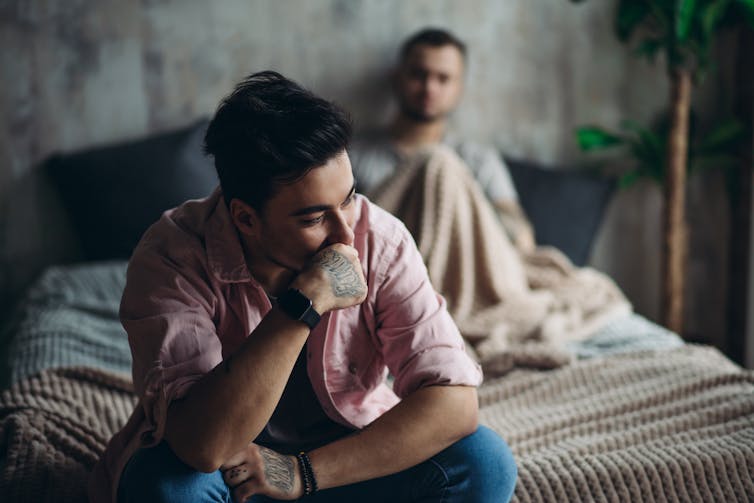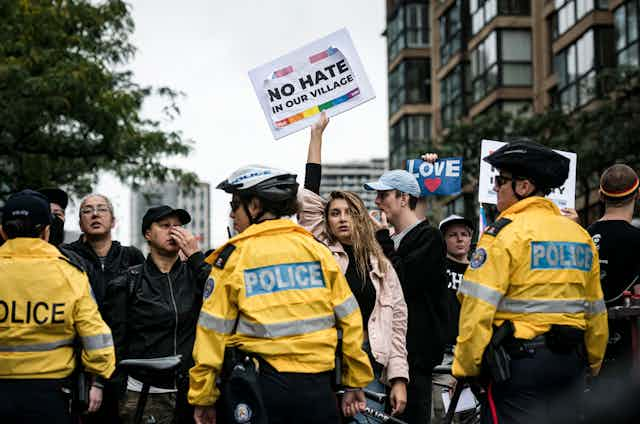Intimate partner violence is a prevalent and growing issue in Canada. According to Statistics Canada, there were 114,132 police-reported victims of intimate partner violence in 2021, marking the seventh consecutive year of increased rates of violence.
Intimate partner violence refers to harmful behaviours perpetrated by a current or former partner over another. This can include physical, sexual, emotional or financial abuse and coercive control.
The issue is particularly significant in the Canadian Prairies, where rates of police-reported intimate partner violence are consistently highest. However, these rates do not reflect the pervasive nature of this issue, as approximately seven out of 10 incidents of intimate partner violence are never reported to police.
Intimate partner violence in 2SLGBTQ+ communities
Considerably less is known about intimate partner violence in 2SLGBTQ+ relationships. This is because less research has focused on 2SLGBTQ+ experiences. In fact, researchers have noted that only three per cent of studies between 1999 and 2013 addressed intimate partner violence in 2SLGBTQ+ relationships.
The data that is avaialable suggests that it is a prevalent issue in 2SLGBTQ+ communities. Statistics Canada estimates that two-thirds of sexual minority women experience intimate partner violence in their lifetime.
Scholars even suggest that rates of intimate partner violence in 2SLGBTQ+ communities are equal to, or higher than, heterosexual relationships. Research has found abusive dynamics in one-quarter to one-half of same-sex relationships.

Police have historically failed to protect 2SLGBTQ+ communities from harm. In fact, as the enforcers of anti-LGBTQ laws in the 20th century, police have actively participated in the oppression of 2SLGBTQ+ communities.
Tensions between police and 2SLGBTQ+ communities notably reached a turning point during the Stonewall Uprising in 1969. The six-day protest was triggered by a police raid at the Stonewall Inn in New York City and served as a driving force for the LGBTQ+ rights movement.
Many advancements and milestones have been achieved in the LGBTQ+ rights movement since the uprising, but the relationship between police and 2SLGBTQ+ communities remains strained. This is largely because poor police practices continue today, with police failing to protect 2SLGBTQ+ survivors from harm — often from intimate partners.
Our research examined how 2SLGBTQ+ communities seek help when experiencing intimate partner violence in the Canadian Prairies. We found that participants’ perceptions and experiences of dealing with police were negative. Police responses ranged from not taking the cases seriously to engaging in discriminatory behaviours towards 2SLGBTQ+ survivors.
Survivor experiences with police
As part of our study, we interviewed 47 2SLGBTQ+ survivors of intimate partner violence across the Canadian Prairies about their experiences. A range of gender identities and sexual orientations were represented including Two-Spirit, transgender, non-binary, genderfluid, gay, lesbian, bisexual, pansexual and asexual. Survivors ranged in age from 19 to 67 years old.
Around 55 per cent were of White/European ancestry, 17 per cent were Indigenous, 15 per cent were of mixed ancestry, six per cent were Black and four per cent were Asian. Almost half (47 per cent) had a mental or physical disability or chronic health condition.
Despite historical harms, many survivors described reaching out to police for help. However, police responses towards them ranged from disinterest at best to discriminatory at worst. While a few survivors reported positive encounters with police, these were reported much less frequently.
Many survivors told us they were not taken seriously when seeking police assistance. This was particularly true for lesbian survivors, who stated that police brushed off abusive incidents as a “catfight” or disagreement “between friends.”
This was echoed by survivors in other 2SLGBTQ+ communities, who felt the disdain they experienced from police invalidated their relationships and severity of abuse they experienced. Overall, misconceptions surrounding what abuse looks like in 2SLGBTQ+ communities were common in police responses.
Other survivors described blatant discrimination at the hands of police, including ridicule and dehumanizing rhetoric on account of their 2SLGBTQ+ identities. Transgender survivors in particular discussed instances of being misgendered, even after repeated attempts to express their proper name and desired pronouns. Discrimination was amplified for survivors with multiple marginalized identities, particularly those from racialized groups.
Changing harmful practices
Current policing practices must be addressed to improve responses to intimate partner violence in 2SLGBTQ+ communities, including demanding more accountability from police.
The survivors we interviewed discussed several recommendations for tackling the issue, beginning with changing police attitudes and behaviours towards 2SLGBTQ+ communities. Specific changes include respecting 2SLGBTQ+ identities and pronouns, validating 2SLGBTQ+ relationships and taking intimate partner violence in 2SLGBTQ+ relationships seriously.
The need for larger systemic change within policing was also discussed. An important step towards systemic change involves committing to in-depth and long-term training to better inform interactions with 2SLGBTQ+ survivors.
Training should be comprehensive and address problematic preconceptions that downplay or dismiss the issue. Holding police accountable for not adequately responding to intimate partner violence within these systems was also noted as crucial to ensuring that training is put into practice.
Finally, increasing the diversity of justice system staff was also recommended. Survivors specifically underscored the importance of having more 2SLGBTQ+ representation in policing. Additionally, having social worker liaisons responding to calls alongside police officers was recommended to better assess and address intimate partner violence.
Violence of all kinds affects people of every gender identity and sexual orientation. However, 2SLGBTQ+ survivors can experience different forms of violence and face additional challenges accessing assistance and support. Police must do better to gain the trust and confidence from 2SLGBTQ+ communities. All survivors of violence, regardless of gender identity and sexual orientation, have the right to safety and protection, including from the police.

